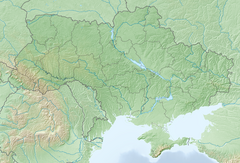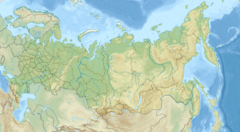The search for extraterrestrial intelligence (SETI) is a collective term for scientific searches for intelligent extraterrestrial life, for example, monitoring electromagnetic radiation for signs of transmissions from civilizations on other planets.

A radio telescope is a specialized antenna and radio receiver used to detect radio waves from astronomical radio sources in the sky. Radio telescopes are the main observing instrument used in radio astronomy, which studies the radio frequency portion of the electromagnetic spectrum emitted by astronomical objects, just as optical telescopes are the main observing instrument used in traditional optical astronomy which studies the light wave portion of the spectrum coming from astronomical objects. Unlike optical telescopes, radio telescopes can be used in the daytime as well as at night.
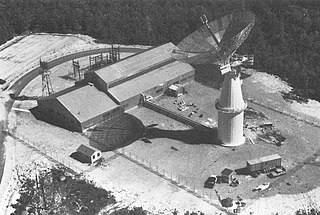
Radar astronomy is a technique of observing nearby astronomical objects by reflecting radio waves or microwaves off target objects and analyzing their reflections. Radar astronomy differs from radio astronomy in that the latter is a passive observation and the former an active one. Radar systems have been conducted for six decades applied to a wide range of Solar System studies. The radar transmission may either be pulsed or continuous. The strength of the radar return signal is proportional to the inverse fourth-power of the distance. Upgraded facilities, increased transceiver power, and improved apparatus have increased observational opportunities.

The Goldstone Deep Space Communications Complex (GDSCC), commonly called the Goldstone Observatory, is a satellite ground station located in Fort Irwin in the U.S. state of California. Operated by NASA's Jet Propulsion Laboratory (JPL), its main purpose is to track and communicate with interplanetary space missions. It is named after Goldstone, California, a nearby gold-mining ghost town.
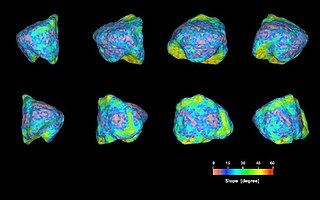
6489 Golevka is an Apollo, Mars-crosser, and Alinda asteroid discovered in 1991 by Eleanor F. Helin.

The communication with extraterrestrial intelligence (CETI) is a branch of the search for extraterrestrial intelligence (SETI) that focuses on composing and deciphering interstellar messages that theoretically could be understood by another technological civilization. The best-known CETI experiment of its kind was the 1974 Arecibo message composed by Frank Drake.

Yevpatoria is a Ukrainian city of regional significance in Western Crimea, north of Kalamita Bay. Yevpatoria serves as the administrative center of Yevpatoria Municipality, one of the districts (raions) into which Crimea is divided. It had a population of 105,719 .
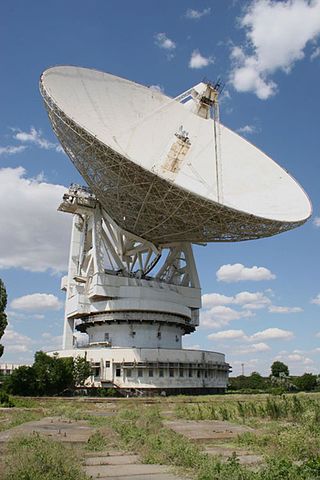
The Teen Age Message (TAM) was a series of interstellar radio transmissions sent from the Yevpatoria Planetary Radar to six solar-type stars during August–September 2001. The structure of the TAM was suggested by Alexander Zaitsev, Chief Scientist at Russia's Institute of Radio-engineering and Electronics. The message's content and target stars were selected by a group of teens from four Russian cities, who collaborated in person and via the Internet. Each transmission comprised three sections: a sounding, a live theremin concert, and digital data including images and text. TAM was humanity's fourth Active SETI broadcast and the first musical interstellar radio message.

Aleksandr Leonidovich Zaitsev was a Russian and Soviet radio engineer and astronomer from Fryazino. He worked on radar astronomy devices, near-Earth asteroid radar research, and SETI.

Yvan Dutil, born April 6, 1970, is a Canadian astrophysicist. He is a member of the Bioastronomy Commission of the International Astronomical Union and of the International Academy of Astronautics's Permanent Committee on the Search for Extra-Terrestrial Intelligence (SETI). He and colleague Stéphane Dumas, created a noise-resistant coding system for messages aimed at communicating with extraterrestrial civilization. This system was used in the creation of messages beamed towards close stars from the Yevpatoria RT-70 radio telescope in Ukraine in 1999 and 2003.

Cosmic Call was the name of two sets of interstellar radio messages that were sent from RT-70 in Yevpatoria, Ukraine in 1999 and 2003 to various nearby stars. The messages were designed with noise-resistant format and characters.

There are three radio telescopes designated RT-70, all in countries that were once part of the former Soviet Union, all with similar specifications: 70m dishes and an operating range of 5–300 GHz. They are a part of the former Soviet Deep Space Network, now operated by Russia. The Yevpatoria facility has also been used as a radar telescope in observations of space debris and asteroids.

The Galenki RT-70 radio telescope is an RT-70 telescope at the East Center for Deep Space Communications, Galenki (Ussuriysk), Russia.
The Suffa RT-70 radio telescope is an RT-70 radio telescope at the Suffa Radio Observatory on the Suffa plateau in Uzbekistan.
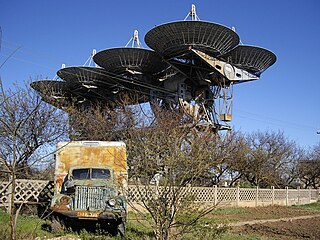
Pluton is a system of deep space communications and planetary radar in Crimea. It was built in the Deep-Space Communication Center area Eighty-Fifth Radiotechnical Center of Distance Communications with Space Objects; ; ; near Yevpatoria in 1960, and consists of at least three antennas. Three of them are of the ADU-1000 design, an assembly of eight reflector antennas, each with diameter of 16 metres. At the North Station, two receiving antennas were built, and a transmitter was constructed 8.5 kilometres away at the South Station.
The Soviet Deep Space Network is a network of large antennas and communication facilities that support interplanetary spacecraft missions, and radio and radar astronomy observations for the exploration of the Solar System and the universe during Soviet times. It was built to support the space missions of the Soviet Union. Similar networks are run by the USA, China, Europe, Japan, and India.


